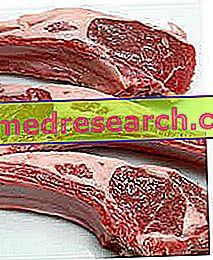Lamb means a young specimen (age not exceeding 12 months) of sheep (female) or ram (male, also called ram); from a taxonomic point of view, the animal belongs to the Bovidae family, Subfamily Capridae, Genus Ovis, Species aries ; the binomial nomenclature of the lamb, therefore, is Ovis aries .
Lamb is a herbivorous domestic creature that is subject to breeding by humans. It can be slaughtered at a young age for the production of meat or, if left to mature, for the production of:
- Milk and derivatives (sheep)
- Lana (sheep and ram)
- Meat (sheep and mutton, the latter castrated or fertile).

Description
Lamb is a herbivorous animal. Initially it feeds exclusively with mother's milk and weaning occurs about 6 weeks after birth. The lamb has a temporary dentition and is characterized by eight milk incisors (on the jaw) of which only the two fronts are replaced at about 12 months of life; others undergo replacement within 4 years or more.
Compared to the adult animal (from 1 to 16-19 years), the lamb is smaller and variable depending on the breed it belongs to; sometimes the hair (still not completely woolly) is darker than the sheep and the ram, while the horns (if present, again according to the breed) are not well formed.
NB . The horns of the sheep, contrary to what one might believe, are not always a peculiarity of the ram; some breeds possess them in both sexes, others in neither, others still see them sprouting on the sheep instead of on the ram.
Lamb meat - gastronomy
Lamb meat can be classified as lean, although it is necessary to take into account that the values shown below refer to the pieces "deprived of visible fat". The lipid supply depends essentially on the cut but, in principle, it is never comparable to that of the adult sheep, cattle or pig. The lamb, in its lean pieces, is however more fat (even if slightly) than the breast obtained from avian meat WITHOUT skin (chicken, turkey etc.). On the other hand, we recall that traditional recipes based on lamb are almost never of a dietary type, except for grilled ribs; a light variant of roast lamb is the Lamb with pistachios (Alice's video recipes), while the most fat lamb-based preparations are: fried lamb chops (breaded), lamb fricassee (abundant oil), leg of oven-baked lamb etc.
Pistachio lamb
X Problems with video playback? Reload from YouTube Go to Video Page Go to Video Recipes Section Watch the video on youtubeSee also the recipe of light-flavored lamb
Properties and nutritional values
The lipids contained in the lamb are prevalently saturated but, since they are contained in small quantities, they should not adversely affect the lipemia of the healthy subject. The amount of cholesterol does not differ much from the average of the meats on the market, but it is advisable to pay attention to the coratella, as it belongs to the offal group.

The total energy supply is not excessive and for certain cuts it even appears low; the most important one refers to the average of the private meat of the visible fat (Lamb, raw), since these include also the belly and high lipid parts.
Among the mineral salts, the contents of potassium and iron stand out (the latter being very useful in the case of iron-deficient anemia), while as regards vitamins, the contribution of niacin (vitamin PP) is remarkable.
Nutritional composition for 100g of Lamb, raw; Cooked lamb; Lamb, leg, raw; Lamb, leg, cooked; Lamb, chop, raw; Lamb, cutlet, cooked; Lamb Coratella [heart, lungs, liver, spleen, kidneys] - Reference Values of Food Composition Tables - INRAN
| Lamb, raw | Lamb, cooked | Lamb, leg, raw | Lamb, leg, cooked | Lamb, chop, raw | Lamb, cutlet, cooked | Lamb Coratella | ||
| Edible part | 100.0% | 100.0% | 100.0% | 100.0% | 100.0% | 100.0% | 100.0% | |
| water | 70.1g | 42.0g | 76.9g | 63.8g | 76.5g | 66.5g | 77.2g | |
| Protein | 20.0g | 35.6g | 20.0g | 31.1g | 20.4g | 28.7g | 15.7g | |
| Prevailing amino acids | B.C. glutamic acid, ac. aspartic, lysine | - | - | - | - | - | - | |
| Limiting amino acid | Tryptophan | - | - | - | - | - | - | |
| Lipids TOT | 8.8g | 14.2g | 2.5g | 4.5g | 2.7g | 4.2g | 4.7g | |
| Saturated fatty acids | 4.28g | -g | 1.01g | 1.83g | 1.09g | 1.76g | -g | |
| Monounsaturated fatty acids | 3.33g | -g | 0.86g | 0.62g | 0.94g | 1.53g | -g | |
| Polyunsaturated fatty acids | 0.42g | -g | 0.35g | 0.51g | 0.33g | 0.43g | -g | |
| Cholesterol | 70.0mg | 110.0mg | 71.0mg | 116.0mg | 75.0mg | 104.0mg | -mg | |
| TOT Carbohydrates | 0.0g | 0.0g | 0.0g | 0.0g | 0.0g | 0.0g | 1.0g | |
| Starch | 0.0g | 0.0g | 0.0g | 0.0g | 0.0g | 0.0g | 0.0g | |
| Soluble sugars | 0.0g | 0.0g | 0.0g | 0.0g | 0.0g | 0.0g | 1.0g | |
| Dietary fiber | 0.0g | 0.0g | 0.0g | 0.0g | 0.0g | 0.0g | 0.0g | |
| Soluble | 0.0g | 0.0g | 0.0g | 0.0g | 0.0g | 0.0g | 0.0g | |
| Insoluble | 0.0g | 0.0g | 0.0g | 0.0g | 0.0g | 0.0g | 0.0g | |
| Power | 159.0kcal | 270.0kcal | 103.0kcal | 165.0kcal | 106.0kcal | 638.0kcal | 109.0kcal | |
| Sodium | 88.0mg | 160.0mg | 68.0mg | 65.0mg | 70.0mg | 71.0mg | -mg | |
| Potassium | 350.0mg | 475.0mg | 338.0mg | 302.0mg | 325.0mg | 309.0mg | -mg | |
| Iron | 1.7mg | 3.2mg | 2.0mg | 3.0mg | 1.7mg | 2.2mg | -mg | |
| Football | 10.0mg | 15.0mg | 10.0mg | 11.0mg | 13.0mg | 12.0mg | -mg | |
| Phosphorus | 190.0mg | 310.0mg | 213.0mg | 230.0mg | 209.0mg | 223.0mg | -mg | |
| Thiamine | 0.15mg | 0.10mg | 0.16mg | 0.10mg | 0.18mg | 0.14mg | -mg | |
| Riboflavin | 0.28mg | 0.33mg | 0.20mg | 0.28mg | 0.19mg | 0.26mg | -mg | |
| Niacin | 6.0mg | 5.1mg | 5.41mg | 4.28mg | 5.76mg | 5.18mg | -mg | |
| Vitamin A | tr | tr | tr | tr | tr | tr | -μg | |
| C vitamin | 0.0mg | 0.0mg | 0.0mg | 0.0mg | 0.0mg | 0.0mg | -mg | |
| Vitamin E | - mg | - mg | - mg | - mg | - mg | - mg | - mg | |



